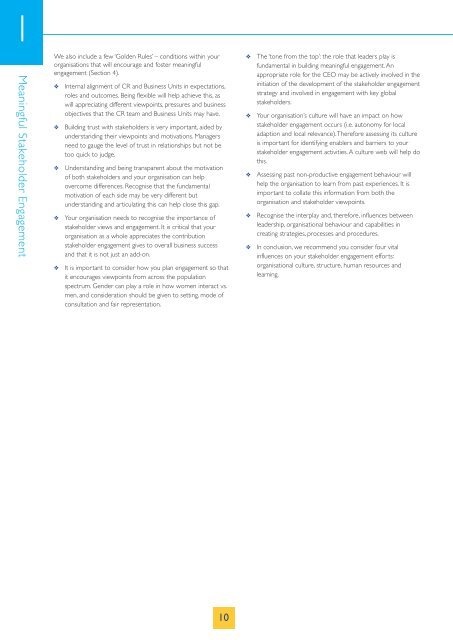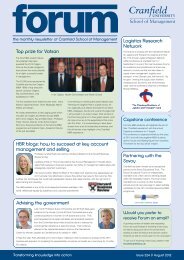Stakeholder Engagement - Cranfield School of Management ...
Stakeholder Engagement - Cranfield School of Management ...
Stakeholder Engagement - Cranfield School of Management ...
You also want an ePaper? Increase the reach of your titles
YUMPU automatically turns print PDFs into web optimized ePapers that Google loves.
1<br />
Meaningful <strong>Stakeholder</strong> <strong>Engagement</strong><br />
We also include a few ‘Golden Rules’ – conditions within your<br />
organisations that will encourage and foster meaningful<br />
engagement (Section 4).<br />
❖ Internal alignment <strong>of</strong> CR and Business Units in expectations,<br />
roles and outcomes. Being flexible will help achieve this, as<br />
will appreciating different viewpoints, pressures and business<br />
objectives that the CR team and Business Units may have.<br />
❖ Building trust with stakeholders is very important, aided by<br />
understanding their viewpoints and motivations. Managers<br />
need to gauge the level <strong>of</strong> trust in relationships but not be<br />
too quick to judge.<br />
❖ Understanding and being transparent about the motivation<br />
<strong>of</strong> both stakeholders and your organisation can help<br />
overcome differences. Recognise that the fundamental<br />
motivation <strong>of</strong> each side may be very different but<br />
understanding and articulating this can help close this gap.<br />
❖ Your organisation needs to recognise the importance <strong>of</strong><br />
stakeholder views and engagement. It is critical that your<br />
organisation as a whole appreciates the contribution<br />
stakeholder engagement gives to overall business success<br />
and that it is not just an add-on.<br />
❖ It is important to consider how you plan engagement so that<br />
it encourages viewpoints from across the population<br />
spectrum. Gender can play a role in how women interact vs.<br />
men, and consideration should be given to setting, mode <strong>of</strong><br />
consultation and fair representation.<br />
10<br />
❖ The ‘tone from the top’: the role that leaders play is<br />
fundamental in building meaningful engagement. An<br />
appropriate role for the CEO may be actively involved in the<br />
initiation <strong>of</strong> the development <strong>of</strong> the stakeholder engagement<br />
strategy and involved in engagement with key global<br />
stakeholders.<br />
❖ Your organisation’s culture will have an impact on how<br />
stakeholder engagement occurs (i.e. autonomy for local<br />
adaption and local relevance).Therefore assessing its culture<br />
is important for identifying enablers and barriers to your<br />
stakeholder engagement activities. A culture web will help do<br />
this.<br />
❖ Assessing past non-productive engagement behaviour will<br />
help the organisation to learn from past experiences. It is<br />
important to collate this information from both the<br />
organisation and stakeholder viewpoints.<br />
❖ Recognise the interplay and, therefore, influences between<br />
leadership, organisational behaviour and capabilities in<br />
creating strategies, processes and procedures.<br />
❖ In conclusion, we recommend you consider four vital<br />
influences on your stakeholder engagement efforts:<br />
organisational culture, structure, human resources and<br />
learning.
















